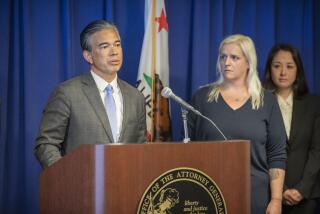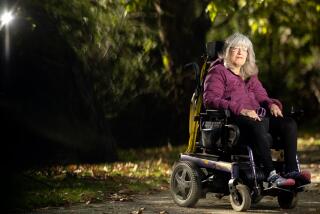Jury decided defects were caused by failure to diagnose and treat ‘hypoxia,’ a lack of oxygen during childbirth. : $8.4 Million Won Over Birth Defects
- Share via
In what is believed to be the largest medical malpractice judgment in California history, Queen of the Valley Hospital in West Covina has been ordered to pay $8.4 million to care for a 5-year-old girl who was left blind, severely retarded and without control of her arms and legs because of negligent care.
Mandi Oostinga suffered the defects because the hospital failed to diagnose and treat a condition known as “hypoxia”--a lack of oxygen--during labor and delivery, a Superior Court jury in Pomona decided Monday.
After hearing almost four weeks of testimony, the jurors decided by a 12-0 vote that the hospital had been negligent in its care of the child and 11 to 1 that the negligence caused the girl’s severe birth defects.
The girl’s doctor, Elena Wong Chen, and a health maintenance organization, General Medical Center, also were sued but they agreed to a settlement for an undisclosed amount early in the trial. Queen of the Valley hospital is likely to subtract the amount of that settlement from the total award of $8,441,285, the child’s attorney, Russell Kussman, said.
Interest-Earning Account
The money is to be placed in an interest-earning account and paid out periodically to cover the child’s care. If she lives a normal life span, the fund could ultimately generate tens of millions of dollars.
Dr. David Rubsamen, an authority on medical malpractice, said the judgment is the largest ever in California. The previous high was $7.6 million awarded in 1978 to Laurie Necochea, a Bay Area woman who became a quadriplegic because of an error in X-ray therapy for thyroid cancer, said Rubsamen, publisher of the Berkeley-based Professional Liability Newsletter. A judge later reduced the amount to $5.6 million, he said.
The award for Necochea included $600,000 for pain and suffering. In the award to Mandi, the amount designated for pain and suffering was $250,000, the maximum under a state law enacted in 1985.
The court dismissed a request that the hospital provide a pain and suffering payment to the girl’s parents, Milo and Elizabeth Oostinga. However, the parents “participated in the settlement” with Chen and General Medical Center, Kussman said. “They certainly suffered extreme emotional distress,” he said.
The money will provide 24-hour nursing care for Mandi, who lives with her family in the Pomona area. “Right now, her full-time nurse and her full-time companion is her mother, and she is just about worn out over this, as you can imagine,” Kussman said.
Testimony convinced jurors that Mandi’s condition was related to a lack of oxygen immediately before and immediately after her birth. The condition went undetected, Kussman said, because Chen monitored the pregnancy mostly through the use of a stethoscope “in this age of electronic monitors. . . . Our point is that by 1981 (standards), that is inadequate care.”
If the condition had been diagnosed, doctors “could have given the mother oxygen, they could have done a Caesarean section. . . . There are several options,” Kussman said.
Waited Two Hours
After the birth and after it was apparent that the child was in poor health, Kussman said, nurses waited two hours before calling a pediatrician. Eighteen hours elapsed before the infant was seen by a doctor, he said.
Efforts by a reporter to reach the hospital’s attorney, Alfred Omansky, were unsuccessful. The hospital contended that the child’s condition is not the result of hypoxia, Kussman said.
Queen of the Valley Hospital may seek a reduction in the award through the courts, attorneys said.
More to Read
Sign up for Essential California
The most important California stories and recommendations in your inbox every morning.
You may occasionally receive promotional content from the Los Angeles Times.









